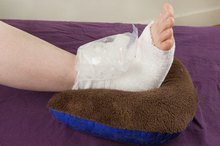How Does a Broken Rib Heal?
Breaking a rib can be extremely painful and uncomfortable. There is virtually nothing you can do to help it along except rest and stay off of your feet. There is no possible way that the bone can be reset or fixed. If you have a broken rib, you will experience swelling and pain in the ribs where the bone is broken. In addition, coughing, sneezing or breathing deeply can cause terrible pain. You may also experience pain if someone presses on your rib cage.
If you are experiencing serious medical symptoms, seek emergency treatment immediately.
The best medicine for a broken rib is to get rest. If you are experiencing severe pain, see a doctor so that he can rule out any severe damage on the inside of the rib cage. In some instances, doctors will bandage you or give you a rib wrap to keep everything in place and to protect the area from being hit accidentally. After a fracture occurs, the blood vessels around the injury begin to constrict, causing any further bleeding to stop. A few hours after the fracture occurs, the hematoma, or extravascular blood cells, gather to form a clot. The cells inside the blood, as well as some of the cells around the outside of the blood clot, break down and die. Fibroblasts, another type of cells, are able to survive and duplicate themselves. They also form a loose pattern of cells that contain granulation tissue or small blood vessels. Within a few days of the fracture, the cells begin to reform and new tissue begins to grow. In time, the broken bone will be bridged by woven bone and cartilage, and some of the bone's original strength will be restored. Eventually, the bone will regain all of its original strength and will be completely healed.
If the fracture is not severe, the healing time will take 3 to 6 weeks, provided that you rest. There is no magic way of getting a bone to heal, because the body will heal it on its own in due time. In the meantime, take it easy and get some rest. After a couple of weeks, you should begin to feel better. If it makes you feel better, you can always wrap your rib cage with gauze or use the wrap that your doctor gave you, if applicable. Wrapping might help hold the rib in place and reduce the amount of pain that you feel when you breath in, sneeze or cough.
Related Articles
References
- Fonseca H, Moreira-Gonçalves D, Coriolano HJ, Duarte JA. Bone quality: The determinants of bone strength and fragility. Sports Med. 2014 Jan;44(1):37-53. doi:10.1007/s40279-013-0100-7
- Office of the Surgeon General (US). Bone Health and Osteoporosis: A Report of the Surgeon General. Rockville (MD): Office of the Surgeon General (US); 2004. 2, The Basics of Bone in Health and Disease.
- Cleveland Clinic. Bone fractures management and treatment.
- American Academy of Orthopaedic Surgeons, OrthoInfo. Internal fixation for fractures.








